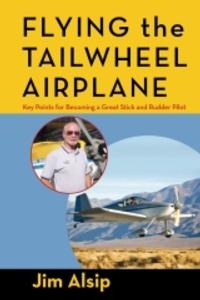Wed, Feb 01, 2012
'Flying The Tail Wheel Airplane' A Detailed Course In
Conventional Gear Flying
Whether its the low, slow flight of a Cub or Champ, or the
high-performance of a P-51, flying an airplane with conventional
gear requires a different skill set. A new book “Flying the
Tail Wheel Airplane”, by Master CFI Jim Alsip, offers a
detailed course on piloting aircraft with a conventional gear. Tail
wheel airplanes present specific challenges that Alsip aims to
address in this guide to better stick and rudder skills.

According to Alsip, there has been a resurgence in pilots flying
tail wheel airplanes in recent years. In part that is due to the
growing popularity and production of new light sport airplanes.
Another factor in the popularity of tail wheel aircraft is safety
and self-esteem. It is generally acknowledged that tail wheel
pilots have better stick and rudder skills than pilots who have
only flown tricycle gear aircraft. Better skills help tail wheel
pilots fly more safely and ostensibly have more fun than their
counterparts in tricycle gear airplanes.
The FAA requires that pilots must have a “tail wheel
endorsement” from a certified flight instructor to fly an
airplane with a tail wheel. To earn a tail wheel endorsement, a
pilot must demonstrate proficiency in specific flying skills and be
knowledgeable of tail wheel subjects. With this in mind, Alsip
guides readers through the basics of tail wheel proficiency and
aims to identify the causes of poor pilot performance. Alsip
contends that the principles laid out in the book are applicable to
all pilots flying all types of small airplanes and are prerequisite
to learning to fly advanced maneuvers safely.
“Many pilots know what is required to perform a specific
maneuver, but their low skill level is an impediment to being
successful,” Alsip says. “In a unique way, the book
addresses those weaknesses with techniques and a practice regimen
that will help any pilot become more skilled with the use of an
airplane’s controls.”
Intended to educate and empower pilots of all backgrounds and
training levels, the book offers step-by-step instructions that
gradually build in complexity as the book progresses. The book also
offers an abundance of photographs from the cockpit demonstrating
key points and principles. The photographs emphasize stick and
rudder skills from the pilot’s perspective. “Emphasis
on where to look, what to see and what to do about it makes this
teaching style and book unique and effective,” says
Alsip.
More News
Aero Linx: Florida Antique Biplane Association "Biplanes.....outrageous fun since 1903." That quote really defines what the Florida Antique Biplane Association (FABA) is all about.>[...]
Beyond Visual Line Of Sight (BVLOS) The operation of a UAS beyond the visual capability of the flight crew members (i.e., remote pilot in command [RPIC], the person manipulating th>[...]
Also: ForeFlight Upgrades, Cicare USA, Vittorazi Engines, EarthX We have a number of late-breaking news highlights from the 2024 Innovation Preview... which was PACKED with real ne>[...]
“For Montaer Aircraft it is a very prudent move to incorporate such reliable institution as Ocala Aviation, with the background of decades in training experience and aviation>[...]
Maximum Authorized Altitude A published altitude representing the maximum usable altitude or flight level for an airspace structure or route segment. It is the highest altitude on >[...]
 ANN's Daily Aero-Linx (04.13.24)
ANN's Daily Aero-Linx (04.13.24) ANN's Daily Aero-Term (04.13.24): Beyond Visual Line Of Sight (BVLOS)
ANN's Daily Aero-Term (04.13.24): Beyond Visual Line Of Sight (BVLOS) Airborne 04.09.24: SnF24!, Piper-DeltaHawk!, Fisher Update, Junkers
Airborne 04.09.24: SnF24!, Piper-DeltaHawk!, Fisher Update, Junkers Aero-News: Quote of the Day (04.14.24)
Aero-News: Quote of the Day (04.14.24) ANN's Daily Aero-Term (04.14.24): Maximum Authorized Altitude
ANN's Daily Aero-Term (04.14.24): Maximum Authorized Altitude



